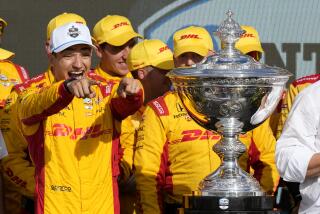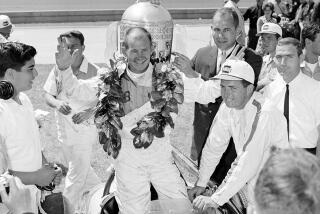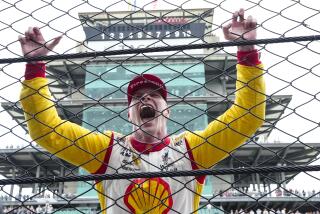INDIANAPOLIS 500 : Everything Goes Green for Fittipaldi : America’s Racing Classic a United Nations Event
INDIANAPOLIS — This is Indy? This is the 500? The race that used to scare (and thrill) America? Hah! Give me the Santa Monica Freeway any old time. Makes this race look like a parking lot.
Remember when the Indianapolis 500 used to be an interesting American tribal rite? Used to be won by guys named Sullivan, Foyt, Jones, Howdy Wilcox, several generations of Unsers?
Well, it was won Sunday for the second time by a Brazilian named Fittipaldi. Second was a Dutchman. Third, a Great Brit. Fourth, another Brazilian. And so on.
The cars already have foreign-born engines and chassis. What’s next--a Kentucky Derby won by a llama?
It wasn’t a race, it was a traffic jam. They should have had horns on the cars. Or traffic cops.
Ray Harroun might have won it. There was no passing in the corners, and not too much of it on the straightaways.
You know what an Indy 500 normally is--a 230-m.p.h. automotive cavalry charge in which the idea is to scream around the track at high gear to shake the ribbon clerks out of the game.
The ribbon clerks were still in this game at the finish. There were 24 cars still running when the checkered flag fell. Nine cars dropped out. Indy usually has that many dropouts by Lap 30. Only 12 cars were running last year, only 11 the year before. The cars this year could have had a one-year warranty. The guys didn’t even need seat belts. The wall hits were just love taps. In fact, Nigel Mansell hit the wall and kept racing. Other years, you’re lucky if you keep breathing.
It was a little bit like watching a Willie Pep fight--a lot of jabbing and dancing out of range. It was safe, but was it Indy? The doctors in the infield hospital must have thought they got the day wrong. Nobody even got a nosebleed.
There were 10 cars running on the same lap at the end. That’s nine more than there usually are. At Indy, you ordinarily don’t have 10 cars running on the last lap, period. One of them is often on Lap 172 when the race is over.
The race was won by owner Roger Penske. And roses are red and violets are blue. Roger knows something about conditioning a car these other guys don’t. He’s the Knute Rockne of this game.
The race was won, really, because the best driver in it didn’t seem to comprehend the rules. At Indy, that’s not unusual. Some of them seem to have been drawn up for Alice In Wonderland.
Mansell had been driving a magnificent race for what was not only his first Indy 500, but his first oval event. In fact, he had the lead with 15 laps to go when, suddenly, Lyn St. James stopped running.
At Indy, when this happens, they slow the race with a yellow caution light. The pace car comes out and the cars line up behind it obediently like the seven dwarfs. They crawl around until the track can be cleared, the debris--human or automotive--removed. The pace car then pulls off and the steward takes out a green flag and waves it.
Nigel Mansell had never been in this situation before. In Europe, they don’t have this kind of caution-light racing.
So, when Nigel Mansell saw the green flag coming out at the finish line, he apparently assumed he had to reach that line before he started racing again.
Big mistake.
Emerson Fittipaldi won because he has been racing at Indianapolis since 1984 and knew the rules only too well. He won the race in 1989. When he saw the green flag, he was a) anticipating it, and b) well aware of what to do. He stood on the throttle.
So did the third-place car driven by another former winner, Arie Luyendyk.
They went by Mansell as if he were tied to a tree. He was later to hit the wall trying to catch them. They were long gone.
Before that, Mansell, learning as he went along, had run a masterful race. He led for 34 laps. He had the race in his knapsack when he got ambushed on Lap 185.
At that, he had less to complain about than the Brazilian, Raul Boesel. In the words of the actor-turned-author Tim Considine, Boesel may be the first guy in the history of the 500 to get ticketed for speeding.
They caught him going through the pits too fast. You wouldn’t think an event in which a driver drove 232.482 m.p.h. would have a speed limit. But Boesel found a way to exceed it.
They don’t fine you at Indy, they black flag you for going too fast. Or going too slow. Black flagging means you have to come in the pits, stop, then go again--while the field laps you.
Boesel got flagged a second time for coming in the pits too soon under a yellow. When you consider his final average speed was 157.141, vs. the winner’s 157.207, you wonder why he doesn’t go find a storefront lawyer to appeal his traffic fines. He could become winner on appeal. “In my mind, I won the race,” he said, resentfully.
Indy does that to you. You have to love Indy. They get you for going too fast--or too slow. For going in the pits. Or for not going in the pits. It’s either too dangerous--or too tame. The track is too narrow--or not narrow enough.
It’s still America’s Race. It’s merely that the winner speaks with an accent. But, shucks, so did Columbus, come to think of it. The only thing you know for sure is that the winner will probably have a green card. And the loser will wish he read all those funny rules.
More to Read
Go beyond the scoreboard
Get the latest on L.A.'s teams in the daily Sports Report newsletter.
You may occasionally receive promotional content from the Los Angeles Times.










